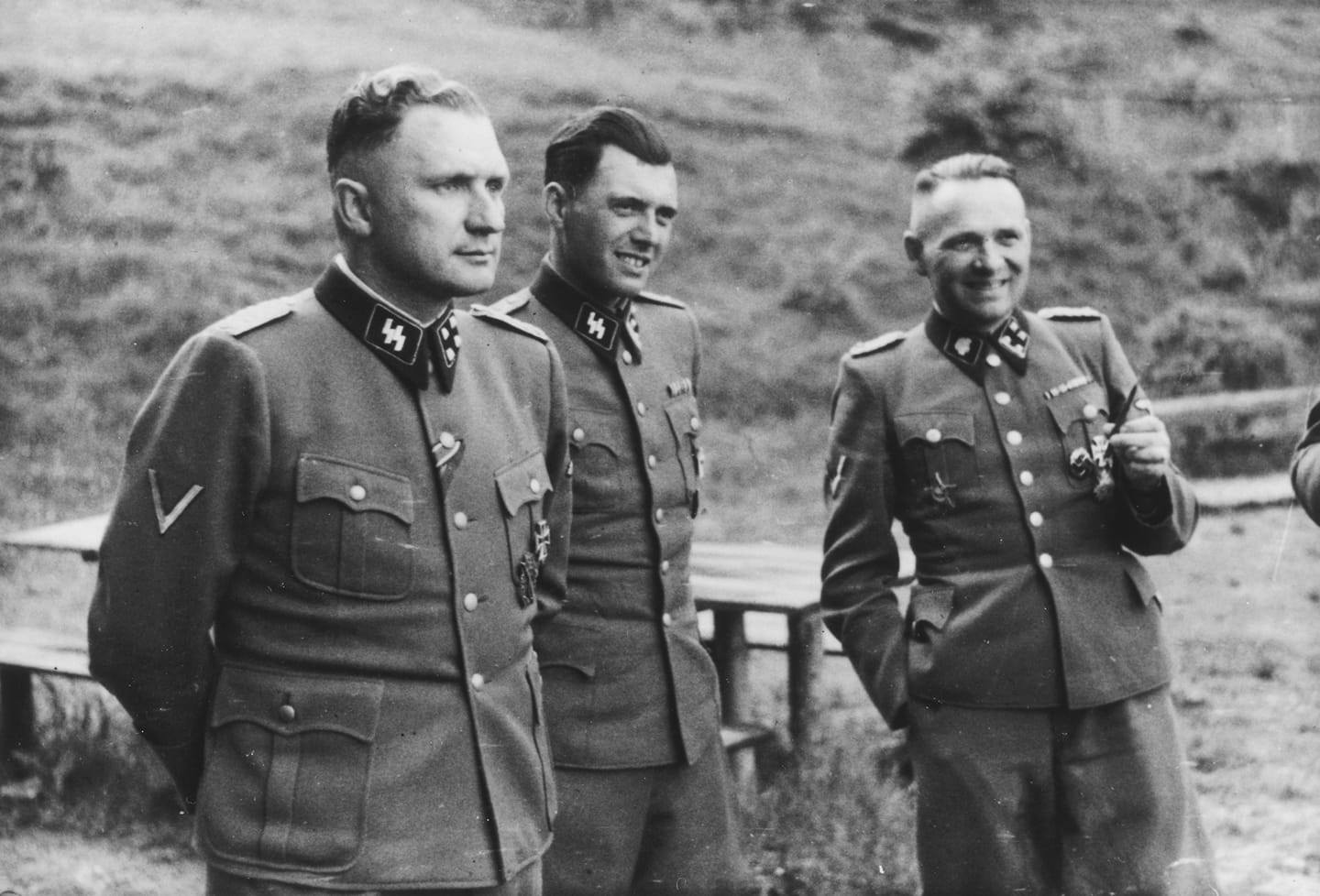
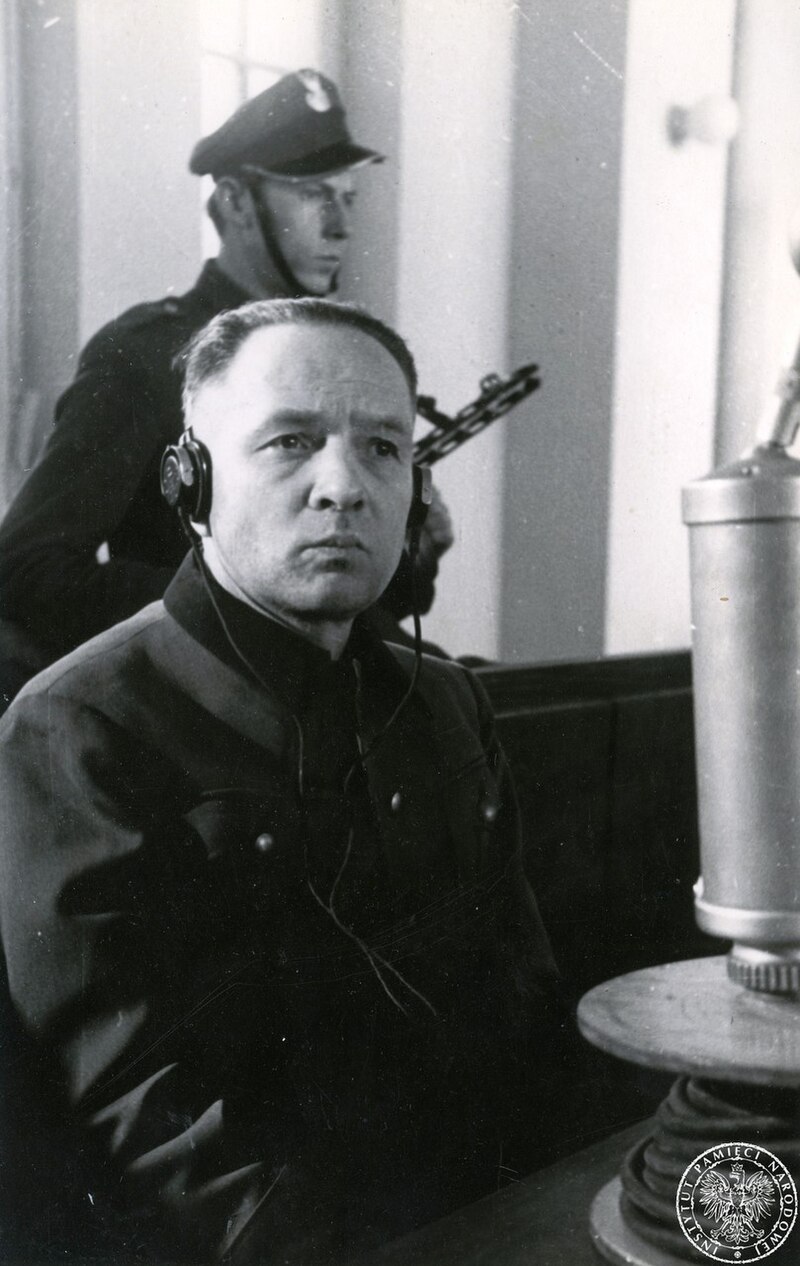
ルドルフ・ヘス
Rudolf Franz Ferdinand Höss,
1901-1947


左
より、Richard Baer=リヒャルト・ベーア (Auschwitz司令官, May 1944-Jan. 1945)、Josef
Mengele 、そしてRudolf Hoess (前任Auschwitz司令官)【写真出典不詳だがブンデスアーカイブか】Josef
Mengele (Mitte) zwischen den Kommandanten Richard Baer (links) und
Rudolf Höß an der Solahütte bei Auschwitz, 1944. Aufnahme aus dem
Auschwitz-Album Karl-Friedrich Höckers.//Rudolf Höss,
commandant of German concentration and death camps of Auschwitz, during
his trial in Warsaw (Poland), after which he was declared guilty then
hanged in 1947 in Auschwitz on the place of his crimes.
☆ ルドルフ・フランツ・フェルディナント・ヘス(Höß、Hoeß、Hoessとも: [hœs]; 1901年11月25日 - 1947年4月16日)[4][5][6]は、ナチス時代のドイツのSS将校であり、ナチス・ドイツの敗戦後、ホロコーストに関与したとして戦争犯罪で有 罪判決を受けた。ヘスはアウシュヴィッツ強制絶滅収容所で最も長く指揮官を務めた(1940年5月4日から1943年11月まで、1944年5月8日から 1945年1月18日まで)。彼は、最終的解決として知られるナチス占領下のヨーロッパのユダヤ人を組織的に絶滅させるというヒトラーの命令を加速させる 手段を試し、実行した。部下のカール・フリッツシュの発案で、ヘスはガス室で使用する殺虫剤ツィクロンBを導入し[7][8]、100万人以上が殺害され た。ヘスは1947年にポーランド最高国民法廷での裁判の後、絞首刑に処された。投獄中、ポーランド当局の要請により、彼は回顧録を執筆し、『アウシュビッツ 司令官(Commandant Of Auschwitz)』というタイトルで英語で発表された: The Autobiography of Rudolf Hoess(ルドルフ・ヘス自伝)
| Rudolf Franz Ferdinand Höss
(also Höß, Hoeß, or Hoess; German pronunciation: [hœs]; 25 November
1901 – 16 April 1947)[4][5][6] was a German SS officer during the Nazi
era who, after the defeat of Nazi Germany, was convicted for war crimes
for his role in the Holocaust. Höss was the longest-serving commandant
of Auschwitz concentration and extermination camp (from 4 May 1940 to
November 1943, and again from 8 May 1944 to 18 January 1945). He tested
and implemented means to accelerate Hitler's order to systematically
exterminate the Jewish population of Nazi-occupied Europe, known as the
Final Solution. On the initiative of one of his subordinates, Karl
Fritzsch, Höss introduced the pesticide Zyklon B to be used in gas
chambers,[7][8] where more than a million people were killed.[9] Höss was hanged in 1947 following a trial before the Polish Supreme National Tribunal. During his imprisonment, at the request of the Polish authorities, he wrote his memoirs, released in English under the title Commandant of Auschwitz: The Autobiography of Rudolf Hoess.[10] |
ル
ドルフ・フランツ・フェルディナント・ヘス(Höß、Hoeß、Hoessとも: [hœs]; 1901年11月25日 -
1947年4月16日)[4][5][6]は、ナチス時代のドイツのSS将校であり、ナチス・ドイツの敗戦後、ホロコーストに関与したとして戦争犯罪で有
罪判決を受けた。ヘスはアウシュヴィッツ強制絶滅収容所で最も長く指揮官を務めた(1940年5月4日から1943年11月まで、1944年5月8日から
1945年1月18日まで)。彼は、最終的解決として知られるナチス占領下のヨーロッパのユダヤ人を組織的に絶滅させるというヒトラーの命令を加速させる
手段を試し、実行した。部下のカール・フリッツシュの発案で、ヘスはガス室で使用する殺虫剤ツィクロンBを導入し[7][8]、100万人以上が殺害され
た[9]。 ヘスは1947年にポーランド最高国民法廷での裁判の後、絞首刑に処された。投獄中、ポーランド当局の要請により、彼は回顧録を執筆し、『アウシュビッツ 司令官』というタイトルで英語で発表された: The Autobiography of Rudolf Hoess』(ルドルフ・ホース自伝)[10]。 |
| Upbringing Höss was born in Baden-Baden into a strict Catholic family.[11] He lived with his mother Lina (née Speck) and father Franz Xaver Höss. Höss was the eldest of three children and the only son. He was baptized Rudolf Franz Ferdinand on 11 December 1901. He was a lonely child with no companions of his own age until he entered elementary school; all of his associations were with adults. He claimed in his autobiography that he was briefly abducted by Romanis in his youth.[12] His father, a former army officer who served in German East Africa, ran a tea and coffee business. He brought his son up on strict religious principles and with military discipline, having decided that he would enter the priesthood. Höss grew up with an almost fanatical belief in the central role of duty in a moral life. During his early years, there was a constant emphasis on sin, guilt, and the need to do penance.[13] |
生い立ち ヘスはバーデン・バーデンの厳格なカトリックの家庭に生まれた[11]。 母リナ(旧姓スペック)、父フランツ・ザヴァー・ヘスと3人で暮らした。ヘスは3人兄弟の長男で、一人息子だった。1901年12月11日、ルドルフ・フ ランツ・フェルディナントの洗礼を受ける。小学校に入るまで同年代の仲間はおらず、大人との付き合いばかりで孤独な子供だった。彼の父親は、ドイツ領東ア フリカに従軍していた元陸軍将校で、紅茶とコーヒーのビジネスを営んでいた。父は息子を厳格な宗教的原則と軍隊の規律に従って育て、自分は神職に就くと決 めていた。ヘスは、道徳的な生活における義務の中心的役割について、ほとんど狂信的な信念をもって育った。幼少期には、罪、罪悪感、懺悔の必要性が常に強 調されていた[13]。 |
| Youth and World War I When World War I began, Höss served briefly in a military hospital and then, at age 14, was admitted to his father's and grandfather's old regiment, the German Army's 21st Regiment of Dragoons. Aged 15, he fought with the Ottoman Sixth Army at Baghdad, at Kut-el-Amara, and in Palestine.[14] Höss was present at the right time and place to have been a witness to the Armenian genocide and Assyrian genocide, events which are not mentioned in his memoirs.[15] While stationed in Turkey, he rose to the rank of Feldwebel (sergeant-in-chief) and at 17 was the youngest non-commissioned officer in the army. Wounded three times and a victim of malaria, he was awarded the Iron Crescent, the Iron Cross first and second class and other decorations.[16] Höss also briefly commanded a cavalry unit. When the news of the armistice reached Damascus, where he was at that time, he and a few others decided not to wait for Allied forces to capture them as prisoners of war, but instead to try to ride all the way back home. This involved traversing the enemy territory of Romania, but they eventually made it back home to Bavaria.[16] |
少年時代と第一次世界大戦 第一次世界大戦が始まると、ヘスは軍病院に短期間勤務した後、14歳で父と祖父の古い連隊であるドイツ陸軍ドラグーン第21連隊に入隊した。15歳のと き、オスマン第六軍とともにバグダッド、クト・エル・アマラ、パレスチナで戦った[14]。ヘスは、アルメニア人虐殺とアッシリア人虐殺を目撃するのに適 切な時と場所にいた[15] 。ヘスは、アルメニア人大虐殺とアッシリア人大虐殺を目撃するのに適切な時と場所にいた。3度の負傷とマラリアの犠牲となったが、鉄三日月章、鉄十字勲章 一等・二等章、その他の勲章を授与された[16]。休戦の知らせが当時彼がいたダマスカスに届くと、彼と他の数人は連合軍が捕虜として自分たちを捕らえる のを待たず、馬で故郷に帰ろうと決心した。そのため、敵地ルーマニアを横断することになったが、最終的にはバイエルンまで帰還した[16]。 |
| Joining the Nazi Party After the Armistice of 11 November 1918, Höss completed his secondary education and soon joined some of the emerging nationalist paramilitary groups, first the East Prussian Volunteer Corps, and then the Freikorps "Rossbach" in the Baltic area, Silesia and the Ruhr. Höss participated in the armed terror attacks on Polish people during the Silesian uprisings against the Germans, and on French nationals during the French Occupation of the Ruhr. After hearing a speech by Adolf Hitler in Munich, he joined the Nazi Party in 1922 (member number 3240) and renounced affiliation with the Catholic Church.[17]  Issue of the Deutschen Fahndungsblatt ("German [Police] Search Journal"] of 30 June 1923, including a "wanted"-notice for Rudolf Höss (at the bottom of the left-hand column of the page on the right-hand side) following the first murder he ever committed in May 1923. On 31 May 1923, in Mecklenburg, Höss and members of the Freikorps attacked and beat to death local schoolteacher Walther Kadow on the wishes of farm supervisor Martin Bormann, who later became Hitler's private secretary.[18] Kadow was believed to have tipped off the French occupational authorities that Freikorps paramilitary soldier Albert Leo Schlageter was carrying out sabotage operations against French supply lines. Schlageter was arrested and executed on 26 May 1923; soon afterwards Höss and several accomplices, including Bormann, took their revenge on Kadow.[18] In 1923, after one of the killers confessed to a local newspaper, Höss was arrested and tried as the ringleader. Although he later claimed that another man was actually in charge, Höss accepted the blame as the group's leader. He was convicted and sentenced (on 15 [19] or 17 March 1924[20]) to ten years in prison, while Bormann received a one-year sentence.[21] Höss was released from prison in July 1928 as part of a general amnesty and joined the Artaman League, an anti-urbanization movement, or back-to-the-land movement, that promoted a farm-based lifestyle. On 17 August 1929, he married Hedwig Hensel (3 March 1908 – 15 September 1989[22]), whom he met in the Artaman League. Between 1930 and 1943 they had five children: two sons (Klaus and Hans-Jürgen) and three daughters (Heidetraut, Inge-Brigitt, and Annegret). Heidetraut, Höss's eldest daughter, was born in 1932; Inge-Brigitt was born on a farm in northern Germany in 1933; and Annegret, the youngest, was born in Auschwitz in November 1943.[23][24] It was during this time that he became acquainted with Heinrich Himmler.[25] |
ナチ党への入党 1918年11月11日の休戦後、ヘスは中等教育を修了し、すぐに新興の民族主義的準軍事組織、最初は東プロイセン義勇軍、次いでバルト地方、シレジア、 ルール地方のフライコルプス "ロスバッハ "に参加した。ヘスは、ドイツ軍に対するシレジアの反乱の際にはポーランド人に対する武装テロ攻撃に参加し、フランス軍のルール占領の際にはフランス人に 対するテロ攻撃に参加した。ミュンヘンでアドルフ・ヒトラーの演説を聞いた後、1922年にナチ党に入党し(党員番号3240)、カトリック教会との関係 を放棄した[17]。  1923年6月30日付の『Deutschen Fahndungsblatt』(『ドイツ(警察)捜索雑誌』)。1923年5月にルドルフ・ヘスが初めて犯した殺人の後、ルドルフ・ヘスの「指名手配」通知が掲載されている(右側のページの左側の列の一番下)。 1923年5月31日、メクレンブルクで、ヘスとフライコルプスのメンバーは、後にヒトラーの私設秘書となる農場監督マルティン・ボルマン(Martin Bormann)の希望で、地元の学校教師ワルテル・カドーを襲撃し、撲殺した[18]。カドーは、フライコルプスの準軍事兵アルベルト・レオ・シュラ ゲーターがフランスの補給線に対して破壊工作を行っていることをフランスの占領当局に密告したと信じられていた。シュラゲーターは逮捕され、1923年5 月26日に処刑された。その直後、ヘスとボルマンを含む数人の共犯者がカドーに復讐した[18]。1923年、殺人者の一人が地元紙に告白した後、ヘスは 逮捕され、首謀者として裁判にかけられた。後に彼は、実際には別の男が責任者であったと主張したが、ヘスはグループのリーダーとして責任を受け入れた。彼 は有罪判決を受け、(1924年3月15日[19]または17日[20])懲役10年の判決を受け、ボルマンは懲役1年の判決を受けた[21]。 ヘスは1928年7月に一般的な恩赦の一環として釈放され、アルタマン同盟に参加した。アルタマン同盟は反都市化運動、つまり土地を取り戻す運動であり、 農業を中心としたライフスタイルを推進した。1929年8月17日、アルタマン同盟で知り合ったヘドウィグ・ヘンゼル(1908年3月3日-1989年9 月15日[22])と結婚。2人の息子(クラウスとハンス・ユルゲン)と3人の娘(ハイデトラウト、インゲ=ブリジット、アンネグレット)である。ヘスの 長女ハイデトラウトは1932年に生まれ、インゲ=ブリギットは1933年にドイツ北部の農場で生まれ、末っ子のアンネグレットは1943年11月にアウ シュヴィッツで生まれた[23][24]。この時期にヘスはハインリヒ・ヒムラーと知り合いになった[25]。 |
| SS career On 1 April 1934 Höss joined the SS, on Himmler's effective call-to-action,[26] and in the same year moved to the Death's Head Units. Höss was assigned to the Dachau concentration camp in December 1934, where he held the post of Block leader. His mentor at Dachau was the then SS-brigadier general Theodor Eicke, the reorganizer of Nazi concentration camp system. In 1938, Höss was promoted to SS-captain and was made adjutant to Hermann Baranowski in the Sachsenhausen concentration camp. There he led the firing squad that, on Himmler's orders on 15 September 1939, killed August Dickman, a Jehovah's Witness who was the first conscientious objector to be executed after the start of the War. Höss fired the finishing shot from his pistol.[27] He joined the Waffen-SS in 1939 after the invasion of Poland. Höss excelled in that capacity, and was recommended by his superiors for further responsibility and promotion. By the end of his tour of duty there, he was serving as administrator of prisoners' property.[28][29] On 18 January 1940, as head of the protective custody camp at Sachsenhausen, Höss ordered all prisoners not assigned to work details to stand outside in frigid conditions reaching -26 Celsius. Most of the inmates had no coats or gloves. When block elders dragged some of the frozen inmates to the infirmary, Höss ordered the infirmary doors to be closed. During the day, 78 inmates died; another 67 died that night.[30] Auschwitz command 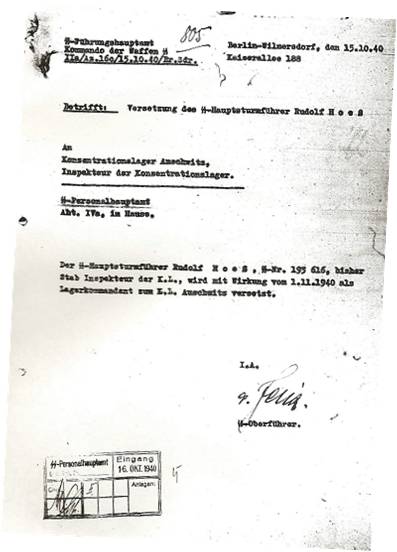 Appointment order of Rudolf Höss as Commander of Auschwitz Concentration Camp Further information: Auschwitz concentration camp Höss was dispatched to evaluate the feasibility of establishing a concentration camp in western Poland, a territory Germany had incorporated into the province of Upper Silesia. His favorable report led to the creation of the Auschwitz camps and his appointment as commandant.[31] The camp was built around an old Austro-Hungarian (and later Polish) army barracks near the town of Oświęcim; its German name was Auschwitz.[32] Höss commanded the camp for three and a half years, during which he expanded the original facility into a sprawling complex known as Auschwitz-Birkenau concentration camp. Höss had been ordered "to create a transition camp for ten thousand prisoners from the existing complex of well-preserved buildings," and he went to Auschwitz determined "to do things differently" and develop a more efficient camp than those at Dachau and Sachsenhausen, where he had previously served.[33] Höss lived at Auschwitz in a villa with his wife and five children.[34] The earliest inmates at Auschwitz were Soviet prisoners-of-war and Polish prisoners including peasants and intellectuals. Some 700 arrived in June 1940, and were told they would not survive more than three months.[35] At its peak, Auschwitz comprised three separate facilities: Auschwitz I, Auschwitz II-Birkenau and Auschwitz III-Monowitz. These included many satellite sub-camps, and the entire camp complex was built on about 8,000 hectares (20,000 acres) that had been cleared of all inhabitants.[28] Auschwitz I was the administrative centre for the complex; Auschwitz II Birkenau was the extermination camp where most of the murders were committed; and Auschwitz III Monowitz was the slave-labour camp for I.G. Farbenindustrie AG, and later other German industries. The main purpose of Monowitz was the production of buna, a form of synthetic rubber. Most infamous at Auschwitz I, the original camp, was Block 11 and the courtyard between Blocks 10 and 11.[36] High stone walls and a massive wooden gate shielded Nazi brutality from observers. A condemned prisoner was led from Block 11, naked and bound, to the Death Wall at the back of the courtyard.[37] A member of the Political Department then shot the prisoner in the back of the head, using a small-caliber pistol to minimize noise. As punishment, Höss also employed standing cells in Block 11. On multiple occasions, he condemned ten random prisoners to death by starvation in a Block 11 cell in retaliation for the escape of one inmate.[38] Mass murder In June 1941, according to Höss's trial testimony, he was summoned to Berlin for a meeting with Himmler "to receive personal orders".[28] Himmler told Höss that Hitler had given the order for the "Final Solution". According to Höss, Himmler had selected Auschwitz for the extermination of Europe's Jews "on account of its easy access by rail and also because the extensive site offered space for measures ensuring isolation". Himmler described the project as a "secret Reich matter" and told Höss not to speak about it with SS-Gruppenführer Richard Glücks, head of the Nazi camp system run by the Death's Head Unit.[28] Höss said that "no one was allowed to speak about these matters with any person and that everyone promised upon his life to keep the utmost secrecy". He told his wife about the camp's purpose only at the end of 1942, since she already knew about it from Fritz Bracht. Himmler told Höss that he would be receiving all operational orders from Adolf Eichmann, who arrived at the camp four weeks later.[28]  Commander of Auschwitz I Richard Baer, Auschwitz chief medical officer Josef Mengele and Höss, 1944 Höss began testing and perfecting techniques of mass murder on 3 September 1941.[39] His experiments led to Auschwitz becoming the most efficiently murderous instrument of the Final Solution and the Holocaust's most potent symbol.[40] According to Höss, during standard camp operations, two or three trains carrying 2,000 prisoners each would arrive daily for four to six weeks. The prisoners were unloaded in the Birkenau camp and subjected to "selection", usually by a member of the SS medical staff.[41][42] Men were separated from women. Only those deemed suitable for Nazi slave labor were allowed to live. The elderly, infirm, children, and mothers with children were sent directly to the gas chambers. Those found fit for labor were marched to barracks in either Birkenau or one of the Auschwitz camps, stripped naked, shorn of all hair, sprayed with disinfectant, and given a tattoo.[43] At first, small gassing bunkers were located deep in the woods to avoid detection. Later, four large gas chambers and crematoria were constructed in Birkenau to make the killing process more efficient, and to handle the sheer volume of victims.[28] Technically [it] wasn't so hard—it would not have been hard to exterminate even greater numbers.... The killing itself took the least time. You could dispose of 2,000 head in half an hour, but it was the burning that took all the time. The killing was easy; you didn't even need guards to drive them into the chambers; they just went in expecting to take showers and, instead of water, we turned on poison gas. The whole thing went very quickly.[44] Höss experimented with various gassing methods. According to Eichmann's trial testimony in 1961, Höss told him that he used cotton filters soaked in sulfuric acid for early killings. Höss later introduced hydrogen cyanide (prussic acid), produced from the pesticide Zyklon B, to the process of extermination, after his deputy Karl Fritzsch had tested it on a group of Russian prisoners in 1941.[8][7] With Zyklon B, he said that it took 3–15 minutes for the victims to die and that "we knew when the people were dead because they stopped screaming."[45] In an interview at Nuremberg after the war, Höss commented that, after observing the prisoners die by Zyklon B, " ...this gassing set my mind at rest for the mass extermination of the Jews was to start soon."[46] In 1942, Höss had sexual relations with a political prisoner at Auschwitz named Eleonore Hodys[47] (or Nora Mattaliano-Hodys).[48] The woman became pregnant, and was imprisoned in a standing-only arrest cell. Released from the arrest, she had an abortion in a camp hospital in 1943 and, according to her later testimony,[49] just barely evaded being selected to be killed. These events may have led to Höss's recall from the Auschwitz command in 1943.[48] SS judge Georg Konrad Morgen and his assistant Wiebeck investigated the case in 1944, interviewed Hodys and Höss and intended to proceed against Höss, but the case was dismissed. Morgen, Wiebeck and Hodys gave testimony after the war.[47][48] After being replaced as the Auschwitz commander by Arthur Liebehenschel, on 10 November 1943, Höss assumed Liebehenschel's former position as the head of Amt D I in Amtsgruppe D of the SS Main Economic and Administrative Office (WVHA); he also was appointed deputy of the inspector of the concentration camps under Richard Glücks. 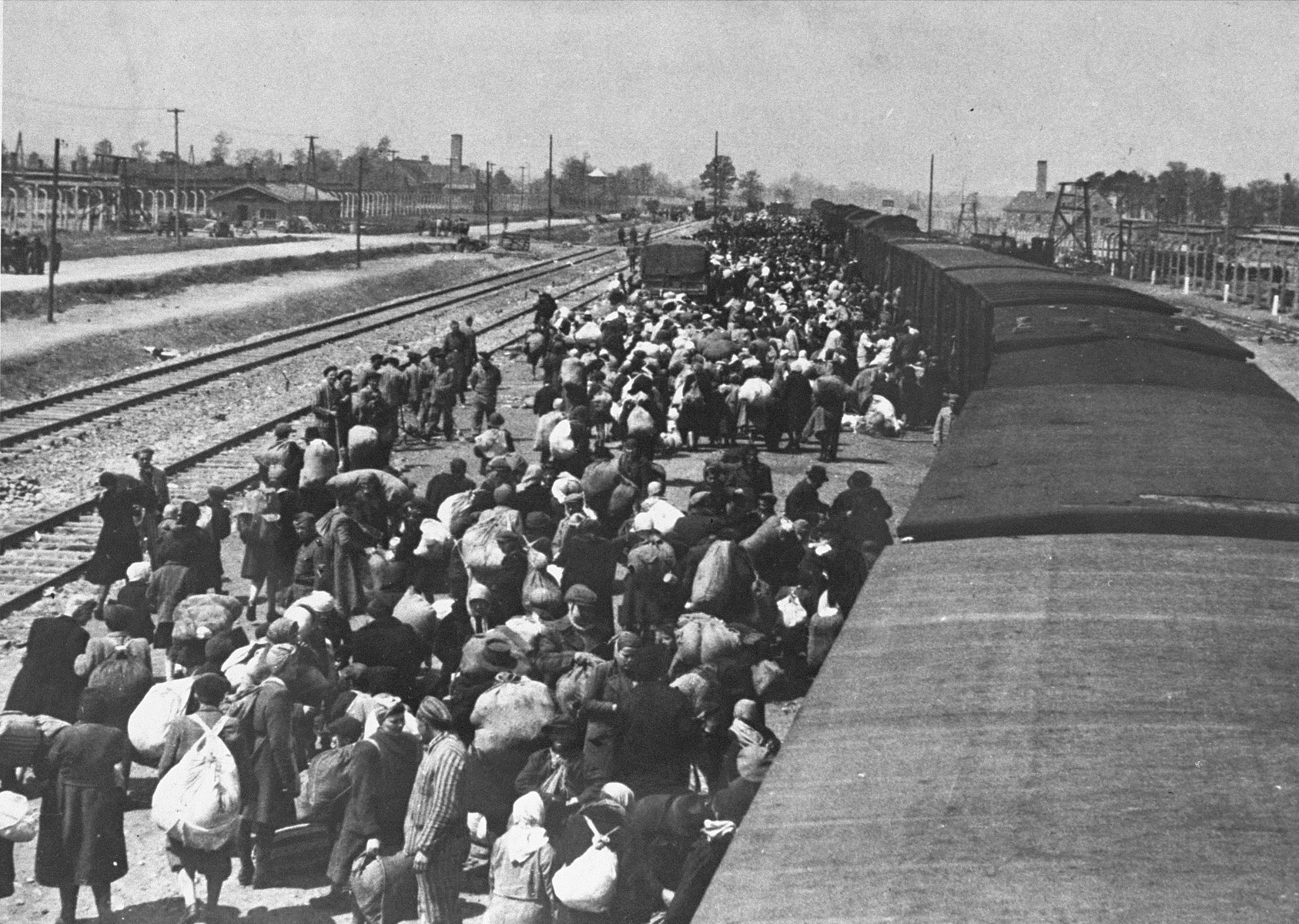 The ramp at Birkenau, 1944. Chimneys of Crematoria II and III are visible on the horizon. Operation Höss On 8 May 1944, Höss returned to Auschwitz to supervise Operation Höss, in which 430,000 Hungarian Jews were transported to the camp and killed in 56 days.[50] Even Höss' expanded facility could not handle the huge number of victims' corpses, and the camp staff were obliged to dispose of thousands of bodies by burning them in open pits.[51] In May and June alone, almost 10,000 Jews were being gassed per day.[52] Because the number of people exceeded the capacity of the gas chambers and crematoria, mass pit executions were established. Jews were forced to undress then led to a hidden fire pit by Sonderkommando where they were shot by the SS, then thrown into the flames. Ravensbrück Höss's final posting was at Ravensbrück concentration camp. He moved there in November 1944 with his family who lived close by. After the completion of the gas chamber, Höss coordinated the operations of killing by gassing, with a death toll of more than 2,000 female prisoners.[3] |
SSでのキャリア 1934年4月1日、ヘスはヒムラーの効果的な招集によってSSに入隊し[26]、同年には死の首領部隊に移った。ヘスは1934年12月にダッハウ強制 収容所に配属され、そこでブロック長を務めた。ダッハウでの彼の指導者は、ナチスの強制収容所システムの再編成者であったテオドール・アイッケSS准将 (当時)であった。1938年、ヘスはSS大尉に昇進し、ザクセンハウゼン強制収容所でヘルマン・バラノフスキの副官になった。そこで彼は、1939年9 月15日、ヒムラーの命令で、エホバの証人であり、開戦後に処刑された最初の良心的兵役拒否者であったアウグスト・ディックマンを殺した銃殺部隊を指揮し た。ヘスはピストルでとどめの一発を撃った[27]。ポーランド侵攻後の1939年にヴァッフェンSSに入隊。ヘスはその任務で優秀な成績を収め、上官か らさらなる責任と昇進を推薦された。1940年1月18日、ザクセンハウゼンの保護収容所の所長として、ヘスは、労働の細部に割り当てられていないすべて の囚人に対して、摂氏マイナス26度に達する極寒の中で外に立っているように命じた。ほとんどの収容者はコートも手袋も持っていなかった。ブロックの長老 が凍えた収容者の何人かを医務室に引きずり込むと、ヘスは医務室のドアを閉めるように命じた。日中、78名の収容者が死亡し、その夜、さらに67名が死亡 した[30]。 アウシュヴィッツ司令部  ルドルフ・ヘスのアウシュヴィッツ強制収容所所長任命命令書 さらなる情報 アウシュヴィッツ強制収容所 ヘスは、ドイツが上シレジア州に編入したポーランド西部に強制収容所を設置する可能性を評価するために派遣された。彼の好意的な報告によって、アウシュ ヴィッツ収容所が創設され、彼が司令官に任命された[31]。収容所は、オシヴィエンチムの町の近くにある古いオーストリア=ハンガリー(後にポーラン ド)軍の兵舎を中心に建設された。ヘスは、「保存状態のよい既存の建物群から1万人の囚人を収容する移行収容所を創設する」ことを命じられ、アウシュ ヴィッツに赴き、「これまでとは違ったやり方をする」ことを決心し、それまで勤務していたダッハウやザクセンハウゼンの収容所よりも効率的な収容所を開発 した[33]。 ヘスはアウシュヴィッツの別荘に妻と5人の子供と住んでいた[34]。 アウシュヴィッツの初期の収容者は、農民や知識人を含むソ連人捕虜とポーランド人捕虜であった。最盛期には、アウシュヴィッツは3つの別々の施設から構成 されていた: アウシュヴィッツI、アウシュヴィッツIIビルケナウ、アウシュヴィッツIIIモノヴィッツである。アウシュヴィッツIはこの複合施設の管理センターであ り、アウシュヴィッツIIビルケナウはほとんどの殺人が行われた絶滅収容所であり、アウシュヴィッツIIIモノヴィッツはI.G.ファルベンインダストリ AGの奴隷労働収容所であった。モノヴィッツの主な目的は、合成ゴムの一種であるブナの生産だった。 元の収容所であるアウシュヴィッツⅠで最も悪名高かったのは、11ブロックと10ブロックと11ブロックの間の中庭であった[36]。高い石壁と巨大な木 製の門が、ナチスの残虐行為を観察者から遮っていた。死刑囚は、裸で縛られたまま、ブロック11から中庭の奥にある死の壁まで連れて行かれた[37]。そ の後、政治部員が、騒音を最小限にするために小口径のピストルを使って、囚人の後頭部を撃った。懲罰として、ヘスはブロック11の立房も採用した。一人の 囚人の脱走に対する報復として、彼は何度も無作為に10人の囚人をブロック11の独房で餓死させた[38]。 大量殺人 1941年6月、ヘスの裁判での証言によれば、彼は「個人的な命令を受けるため」にベルリンに呼び出され、ヒムラーと面会した[28]。ヒムラーはヘス に、ヒトラーが「最終的解決」の命令を下したことを告げた。ヘスによると、ヒムラーはヨーロッパのユダヤ人絶滅のためにアウシュヴィッツを選んだが、その 理由は「鉄道でのアクセスが容易であったことと、広大な敷地が隔離措置のためのスペースを提供していたから」であった。ヒムラーはこの計画を「帝国の秘密 事項」とし、死の首領部隊によって運営されていたナチスの収容所システムの責任者であるリヒャルト・グリュクス親衛隊上級大将とはこの件について話さない ようにとヘスに告げた[28]。ヘスは、「誰もこの問題について誰とも話すことは許されず、誰もが最大限の秘密を守ることを命がけで約束した」と述べてい る。妻はすでにフリッツ・ブラヒトからそのことを知っていたので、彼は1942年末になって初めて収容所の目的について妻に話した。ヒムラーは、4週間後 に収容所に到着したアドルフ・アイヒマンからすべての作戦命令を受けることになるとヘスに告げた[28]。  アウシュヴィッツIの司令官リヒャルト・ベール、アウシュヴィッツの主任衛生官ヨーゼフ・メンゲレとヘス、1944年 ヘスは、1941年9月3日に大量殺戮技術のテストと完成を開始した[39]。彼の実験によって、アウシュヴィッツは最終解決のもっとも効率的な殺戮手段 となり、ホロコーストのもっとも強力な象徴となった[40]。 ヘスによると、標準的な収容所運営では、4週間から6週間にわたって、毎日2,000名ずつの囚人を乗せた2、3本の列車が到着していた。囚人たちはビル ケナウ収容所に降ろされ、通常SSの医療スタッフによって「選別」された[41][42]。ナチスの奴隷労働に適しているとみなされた者だけが生きること を許された。老人、病弱者、子供、子供を連れた母親は直接ガス室に送られた。労働に適しているとみなされた者は、ビルケナウかアウシュヴィッツ収容所のい ずれかのバラックに行進させられ、裸にされ、すべての髪の毛を刈り取られ、消毒薬を吹きかけられ、入れ墨を入れられた[43]。その後、殺戮プロセスをよ り効率的にし、大量の犠牲者を処理するために、ビルケナウに4つの大きなガス室と火葬場が建設された[28]。 技術的には[それは]それほど難しいことではなかった。殺すこと自体にかかる時間は最も短かった。30分もあれば2,000人の首を処分できたが、時間が かかったのは焼却のほうだった。彼らはシャワーを浴びるつもりで入っただけなのに、水の代わりに毒ガスを使ったのだ。全体があっという間に終わった [44]。 ヘスはさまざまなガス処刑方法を実験した。1961年のアイヒマンの裁判での証言によると、ヘスは初期の殺害には硫酸に浸した綿のフィルターを使ったと 語っている。ヘスはその後、殺虫剤ツィクロンBから生成されたシアン化水素(プルシン酸)を、1941年に副官カール・フリッツシュがロシア人囚人のグ ループでテストした後、絶滅のプロセスに導入した[8][7]。ツィクロンBで は、犠牲者が死ぬのに3-15分かかり、「人々が悲鳴をあげなくなったので、死んだことがわかった」と述べている[45]。 「戦後のニュルンベルクでのインタビューで、ヘスは、囚人たちがツィクロンBによって死ぬのを観察した後、「...このガス処刑によって、ユダヤ人の大量 絶滅がまもなく開始されることになり、私の心は安らいだ」とコメントした[46]。 1942年、ヘスはアウシュヴィッツの政治犯エレオノーレ・ホディス[47](あるいはノラ・マッタリーノ=ホディス)と性的関係を持った[48]。逮捕 から釈放された彼女は、1943年に収容所の病院で中絶を行い、後の証言によれば、ぎりぎりのところで殺されることを免れた[49]。これらの出来事が、 1943年にヘスがアウシュヴィッツ司令部から呼び戻されることにつながったのかもしれない[48]。SS判事ゲオルク・コンラート・モルゲンとその助手 ヴィーベックは1944年にこの事件を調査し、ホーディスとヘスに面談し、ヘスを訴追するつもりであったが、事件は却下された。モルゲン、ヴィーベック、 ホーディスは戦後に証言を行った[47][48]。 1943年11月10日、アウシュヴィッツ司令官をアルトゥール・リーベヘンシェル(Arthur Liebehenschel)に交代させられたヘスは、リーベヘンシェルの元職であるSS主要経済管理局(WVHA)のアムツグルッペDのアムトD Iの長に就任した。  1944年、ビルケナウのタラップ。火葬場IIとIIIの煙突が地平線上に見える。 ヘス作戦 1944年5月8日、ヘスはヘス作戦を監督するためにアウシュヴィッツに戻った。このヘス作戦では、43万人のハンガリー系ユダヤ人が収容所に移送され、 56日間で殺された[50]。ヘスの拡張された施設でさえ、膨大な数の犠牲者の死体を処理することができず、収容所職員は何千もの死体を露天穴で焼却処分 せざるをえなかった。 [51]5月と6月だけで、1日にほぼ1万人のユダヤ人がガス処刑されていた[52]。人数がガス室と火葬場の収容能力を超えていたために、大量竪穴処刑 が確立された。ユダヤ人は強制的に服を脱がされた後、ゾンダーコマンドによって隠された火刑場に導かれ、そこでSSによって射殺された後、炎の中に投げ込 まれた。 ラーベンスブリュック ヘスの最後の配属先はラーヴェンスブリュック強制収容所だった。1944年11月、近くに住んでいた家族とともにそこに移った。ガス室の完成後、ヘスはガス処刑による殺戮作戦を調整し、2000人以上の女性捕虜の死者を出した[3]。 |
| Arrest, trial and execution In the last days of the war, Himmler advised Höss to disguise himself as a member of the Kriegsmarine. Adopting the pseudonym "Franz Lang" and working as a gardener, Höss lived in Gottrupel, Schleswig-Holstein, with his family and evaded arrest for nearly a year.[53][54] In 1946, Hanns Alexander, a German Jew who had fled to England in 1936 and became a Nazi hunter working for the British government's "No. 1 War Crimes Investigation Team", managed to discover Höss's location. Alexander, who was then a captain in the Royal Pioneer Corps, travelled to Höss's residence with a group of British soldiers, many of whom were also Jewish. Alexander's men unsuccessfully interrogated Höss's daughter Brigitte for information; according to Brigitte, the soldiers subsequently started to beat her brother Klaus, leading to Höss's wife to give up his location.[55][56] According to Alexander, Höss attempted to bite into a cyanide pill once he was discovered by the soldiers.[57] He initially denied his identity, "insisting he was a lowly gardener, but Alexander saw his wedding ring and ordered Höss to take it off, threatening to cut off his finger if he did not. Höss' name was inscribed inside. The soldiers accompanying Alexander began to beat Höss with axe handles. After a few moments and a minor internal debate, Alexander pulled them off."[53][58] Rudolf Höss testified at the International Military Tribunal at Nuremberg on 15 April 1946, where he gave a detailed accounting of his crimes. He was called as a defense witness by Ernst Kaltenbrunner's lawyer, Kurt Kauffman.[59][60] The transcript of Höss' testimony was later entered as evidence during the 4th Nuremberg Military Tribunal, known as the Pohl Trial for principal defendant Oswald Pohl.[61] Affidavits that Rudolf Höss made while imprisoned in Nuremberg were also used at the Pohl and IG Farben trials. In his affidavit made at Nuremberg on 5 April 1946, Höss stated: I commanded Auschwitz until 1 December 1943, and estimate that at least 2,500,000 victims were executed and exterminated there by gassing and burning, and at least another half million succumbed to starvation and disease, making a total of about 3,000,000 dead. This figure represents about 70% or 80% of all persons sent to Auschwitz as prisoners, the remainder having been selected and used for slave labor in the concentration camp industries. Included among the executed and burnt were approximately 20,000 Russian prisoners of war (previously screened out of Prisoner of War cages by the Gestapo) who were delivered at Auschwitz in Wehrmacht transports operated by regular Wehrmacht officers and men. The remainder of the total number of victims included about 100,000 German Jews, and great numbers of citizens (mostly Jewish) from The Netherlands, France, Belgium, Poland, Hungary, Czechoslovakia, Greece, or other countries. We executed about 400,000 Hungarian Jews alone at Auschwitz in the summer of 1944.[62] When accused of murdering three and a half million people, Höss replied, "No. Only two and one half million—the rest died from disease and starvation."[63] 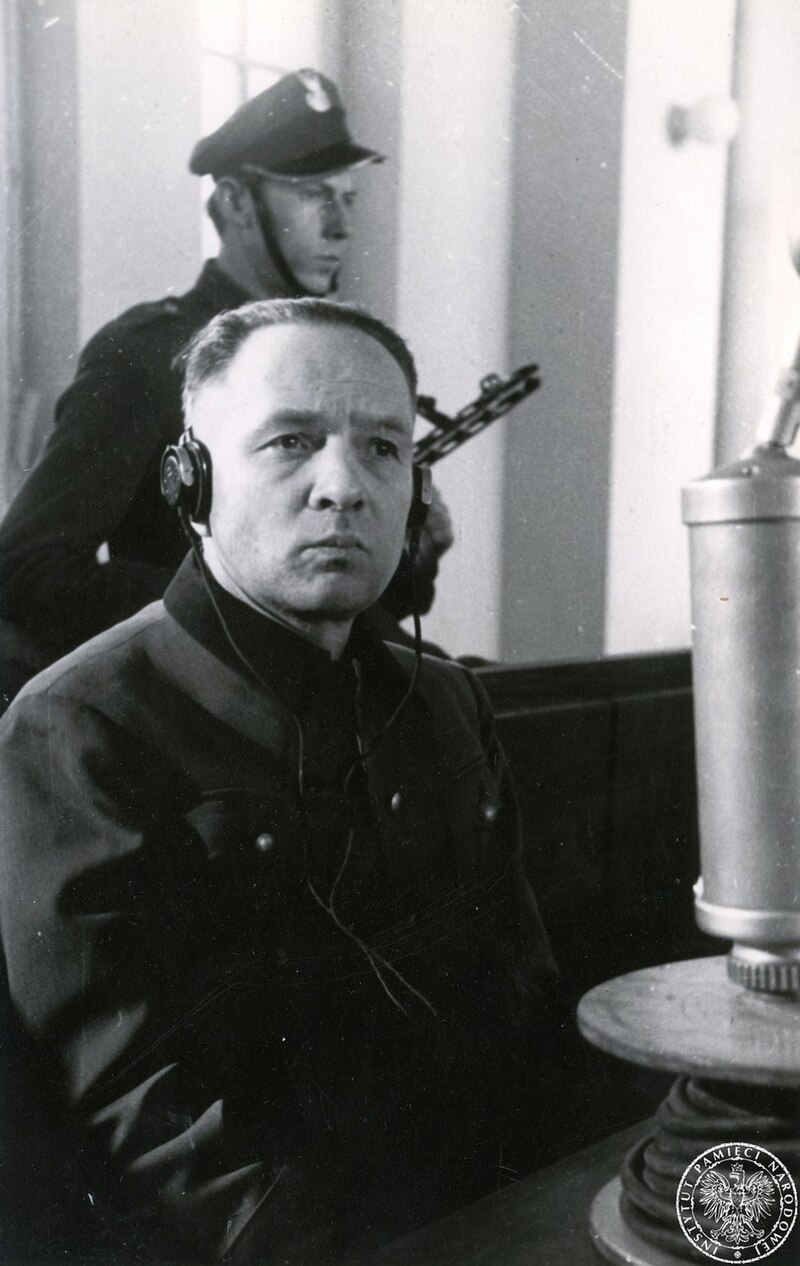 On 25 May 1946, he was handed over to Polish authorities and the Supreme National Tribunal in Poland tried him for murder. In his essay on the Final Solution in Auschwitz, which he wrote in Kraków, he revised the previously given death toll:[64] I myself never knew the total number, and I have nothing to help me arrive at an estimate. I can only remember the figures involved in the larger actions, which were repeated to me by Eichmann or his deputies. From Upper Silesia and the General Gouvernement 250,000 Germany and Theresienstadt 100,000 Holland 95,000 Belgium 20,000 France 110,000 Greece 65,000 Hungary 400,000 Slovakia 90,000 [Total 1,130,000] I can no longer remember the figures for the smaller actions, but they were insignificant by comparison with the numbers given above. I regard a total of 2.5 million as far too high. Even Auschwitz had limits to its destructive capabilities. In his memoir, he also revealed his mistreatment at the hands of his British captors:[65] During the first interrogation they beat me to obtain evidence. I do not know what was in the transcript, or what I said, even though I signed it, because they gave me liquor and beat me with a whip. It was too much even for me to bear. The whip was my own. By chance it had found its way into my wife's luggage. My horse had hardly ever been touched by it, much less the prisoners. Somehow one of the interrogators probably thought that I had used it to constantly whip the prisoners. After a few days I was taken to Minden on the Weser River, which was the main interrogation center in the British zone. There they treated me even more roughly, especially the first British prosecutor, who was a major. The conditions in the jail reflected the attitude of the first prosecutor. [...] Compared to where I had been before, Imprisonment with the IMT [International Military Tribunal] was like staying in a health spa. His trial lasted from 11 to 29 March 1947. Höss was sentenced to death by hanging on 2 April 1947. The sentence was carried out on 16 April next to the crematorium of the former Auschwitz I concentration camp. He was hanged on a short-drop gallows constructed specifically for that purpose, at the location of the camp's Gestapo. The message on the board that marks the site reads: This is where the camp Gestapo was located. Prisoners suspected of involvement in the camp's underground resistance movement or of preparing to escape were interrogated here. Many prisoners died as a result of being beaten or tortured. The first commandant of Auschwitz, SS-Obersturmbannführer Rudolf Höss, who was tried and sentenced to death after the war by the Polish Supreme National Tribunal, was hanged here on 16 April 1947.  Höss being escorted to the gallows, 1947 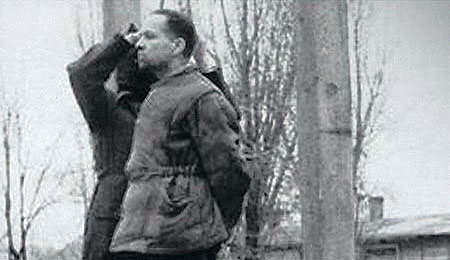 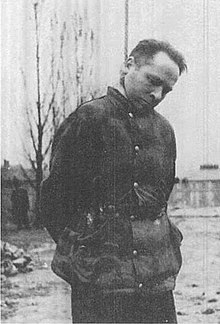 Höss on the gallows, immediately before his execution Höss wrote his autobiography while awaiting execution; it was published first in a Polish translation in 1951 and then in the original German in 1956, edited by Martin Broszat.[66] Later it appeared in various English editions (see Bibliography). It consists of two parts, one about his own life and the second about other SS men with whom he had become acquainted, mainly Heinrich Himmler and Theodor Eicke, among several others.[67] Höss blamed his subordinates and kapos, prisoner functionaries, for the mistreatment of prisoners.[68] He claimed that, despite his best efforts, he was unable to stop the abuse. He also stated that he was never cruel and never mistreated any inmate. Höss blamed Hitler and Himmler for using their powers "wrongly and even criminally." He saw himself as, " ... a cog in the wheel of the great extermination machine created by the Third Reich."  The location where Höss was hanged, with plaque After discussions with Höss during the Nuremberg trials at which he testified, the American military psychologist Gustave Gilbert wrote the following: In all of the discussions, Höss is quite matter-of-fact and apathetic, shows some belated interest in the enormity of his crime, but gives the impression that it never would have occurred to him if somebody hadn't asked him. There is too much apathy to leave any suggestion of remorse and even the prospect of hanging does not unduly stress him. One gets the general impression of a man who is intellectually normal, but with the schizoid apathy, insensitivity and lack of empathy that could hardly be more extreme in a frank psychotic.[69] Four days before he was executed, Höss acknowledged the enormity of his crimes in a message to the state prosecutor: My conscience compels me to make the following declaration. In the solitude of my prison cell, I have come to the bitter recognition that I have sinned gravely against humanity. As Commandant of Auschwitz, I was responsible for carrying out part of the cruel plans of the 'Third Reich' for human destruction. In so doing I have inflicted terrible wounds on humanity. I caused unspeakable suffering for the Polish people in particular. I am to pay for this with my life. May the Lord God forgive one day what I have done. I ask the Polish people for forgiveness. In Polish prisons I experienced for the first time what human kindness is. Despite all that has happened I have experienced humane treatment which I could never have expected, and which has deeply shamed me. May the facts which are now coming out about the horrible crimes against humanity make the repetition of such cruel acts impossible for all time.[33] Shortly before his execution, Höss returned to the Catholic Church. On 10 April 1947, he received the sacrament of penance from Fr. Władysław Lohn [pl], S.J., provincial of the Polish Province of the Society of Jesus. On the next day, the same priest administered to him Holy Communion as Viaticum. On 16 April 1947 Höss was hanged. At the request of former camp prisoners, the execution was carried out in Auschwitz, the camp he once commanded. Approximately one hundred witnesses were present including former prisoners and various high-ranking officials of the Polish government. Höss's was the last public execution in Poland.[70] |
逮捕、裁判、処刑 戦争末期、ヒムラーはヘスにドイツ海軍の一員に変装するよう助言した。フランツ・ラング」という偽名を名乗り、庭師として働いていたヘスは、家族とともに シュレースヴィヒ=ホルシュタインのゴットルペルに住み、1年近く逮捕を免れた[53][54]。 1946年、1936年にイギリスに逃れ、イギリス政府の「No.1戦争犯罪調査チーム」で働くナチ・ハンターとなったドイツ系ユダヤ人のハンス・アレク サンダーが、ヘスの居場所を突き止めることに成功した。当時、王立開拓団の大尉だったアレクサンダーは、同じくユダヤ人が多いイギリス兵の一団とともにヘ スの邸宅に向かった。アレクサンダーの部下たちはヘスの娘ブリギッテに情報を求めて尋問したが失敗した。ブリギッテによれば、兵士たちはその後、彼女の兄 クラウスを殴り始め、ヘスの妻がヘスの居場所を明かすに至った[55][56]。アレクサンダーによれば、ヘスは兵士たちに発見されると青酸カリを噛もう とした。指輪の内側にはヘスの名前が刻まれていた。アレクサンダーに同行していた兵士たちは、斧の柄でヘスを殴り始めた。しばらくして、ちょっとした内輪 もめの後、アレクサンダーはそれを引き剥がした」[53][58]。 ルドルフ・ヘスは1946年4月15日にニュルンベルクの国際軍事法廷で証言し、そこで自分の犯罪について詳細に説明した。彼はエルンスト・カルテンブル ンナーの弁護士クルト・カウフマンによって弁護側証人として召喚された[59][60]。ヘスの証言録取書は後に、主犯格オズワルド・ポールのポール裁判 として知られる第4回ニュルンベルク軍事法廷の証拠として提出された[61]。ルドルフ・ヘスがニュルンベルクに収監されている間に作成した宣誓供述書は ポール裁判とIGファルベン裁判でも使用された。 1946年4月5日にニュルンベルクで作成された供述書で、ヘスはこう述べている: 私は1943年12月1日までアウシュヴィッツを指揮しており、少なくとも250万人の犠牲者がそこでガス処刑と焼却によって処刑・絶滅され、さらに少な くとも50万人が飢餓と病気で倒れ、合計で約300万人が死亡したと推定している。この数字は、アウシュヴィッツに囚人として送られた全人口の約70%か 80%に相当し、残りは、強制収容所の産業で奴隷労働者として選別され、利用された。処刑され焼却された者の中には、約20,000名のロシア人戦争捕虜 (以前はゲシュタポによって捕虜檻から選別されていた)が含まれており、彼らは、ドイツ国防軍の正規将校と将兵によって運営されたドイツ国防軍輸送車でア ウシュヴィッツに送られた。犠牲者総数の残りには、約10万のドイツ系ユダヤ人と、オランダ、フランス、ベルギー、ポーランド、ハンガリー、チェコスロバ キア、ギリシャ、その他の国々からの多数の市民(ほとんどがユダヤ人)が含まれていた。1944年夏、アウシュヴィッツでハンガリー系ユダヤ人だけで約 40万人を処刑した[62]。 350万人を殺害したと非難されたとき、ヘスは「いや、250万人だけだ。残りは病気と飢えで死んだ」と答えた[63]。  1946年5月25日、彼はポーランド当局に引き渡され、ポーランドの最高民族裁判所は彼を殺人罪で裁いた。クラクフで書いたアウシュヴィッツの最終解決に関するエッセイの中で、彼は、それまで与えられていた死者数を次のように修正している[64]。 私自身は総数を知らなかったし、概算を出すのに役立つものは何もない。 私が覚えているのは、アイヒマンか彼の代理が私に繰り返した、大規模な行動に関与した数字だけである。 上部シレジアと総督府から25万人 ドイツとテレジエンシュタット 100,000 オランダ 95,000 ベルギー 20,000人 フランス 110,000人 ギリシャ 65,000 ハンガリー 400,000人 スロバキア 90,000[合計 1,130,000] 小規模な行動の数字はもう覚えていないが、上記の数字に比べれば取るに足らないものだった。私は、合計250万人という数字は高すぎると考えている。アウシュビッツでさえ、その破壊力には限界があった。 回想録の中で、彼はイギリス人捕虜の手による虐待についても明らかにしている[65]。 最初の尋問では、彼らは証拠を得るために私を殴った。彼らは私に酒を飲ませ、鞭で叩いたからです。私には耐えがたいことでした。その鞭は私のものだった。 偶然、妻の荷物に入っていたのだ。私の馬はほとんど触られたことがなかった。どういうわけか尋問官の一人は、私が囚人たちを常に鞭で打つのに使っていると 思ったのだろう。 数日後、私はヴェーザー川沿いのミンデンに連行されたが、そこはイギリス領の主な尋問センターだった。そこではさらに手荒く扱われ、特に最初のイギリス人検事は少佐だった。拘置所の状況は、最初の検事の態度を反映していた。[...] 以前いたところと比べると、IMT(国際軍事裁判)への投獄は、健康ランドにいるようなものでした」。 彼の裁判は1947年3月11日から29日まで続いた。ヘスは1947年4月2日に絞首刑の判決を受けた。判決は4月16日、旧アウシュヴィッツ第一強制 収容所の火葬場の隣で執行された。彼は、収容所のゲシュタポがあった場所で、そのために特別に作られた短い絞首台で絞首刑に処された。この場所を示すボー ドにはこう書かれている: ここに収容所のゲシュタポがあった。収容所の地下抵抗運動への関与や逃亡準備の疑いのある囚人は、ここで尋問された。多くの囚人が殴られたり、拷問された りして死んだ。アウシュビッツの初代司令官であったSS親衛隊上級大将ルドルフ・ヘスは、戦後、ポーランド最高民族裁判によって裁かれ、死刑判決を受けた が、1947年4月16日、ここで絞首刑に処された。  絞首台へ護送されるヘス(1947年   絞首台で処刑直前のヘス ヘスは処刑を待つ間に自伝を執筆し、1951年にポーランド語訳が出版され、1956年にはマルティン・ブロスザット編集のドイツ語原書が出版された [66]。ヘスは、囚人への虐待について部下や囚人係のカポスを非難した[68]。彼はまた、自分は決して残酷ではなく、いかなる囚人も虐待したことはな いと述べた。ヘスは、ヒトラーとヒムラーが「間違って、犯罪的にさえ」権力を行使したことを非難した。彼は自分自身を「......第三帝国によって作ら れた偉大な絶滅マシンの歯車」だと考えていた。  ヘスが絞首刑にされた場所とプレート ニュルンベルク裁判で証言したヘスとの話し合いの後、アメリカの軍事心理学者グスタフ・ギルバートは次のように書いている: どのような議論においても、ヘスはきわめて淡々としていて無気力であり、自分の犯した罪の重大さに遅ればせながら関心を示しているが、誰かが尋ねなければ 思いもしなかったような印象を与えている。無気力すぎて後悔の念は感じられず、絞首刑の見通しさえも彼に過度のストレスを与えない。知的には正常だが、分 裂病的な無気力、鈍感さ、共感性の欠如を持つ男という一般的な印象を受ける。 処刑される4日前、ヘスは州検察官に宛てたメッセージの中で、自分の犯した罪の重大さを認めている: 私の良心は次のように宣言せざるを得ません。独房の孤独の中で、私は人類に対して重大な罪を犯したという苦い認識に至りました。アウシュヴィッツの司令官 として、私は、『第三帝国』の残酷な人間破壊計画の一部を遂行する責任を負っていました。そうすることで、私は人類にひどい傷を負わせた。特にポーランド の人々に言いようのない苦しみを与えた。私は命をもってその償いをしなければならない。いつか主なる神が私のしたことをお許しくださいますように。私は ポーランドの人々に許しを請います。ポーランドの刑務所で、私は初めて人間の優しさとは何かを経験しました。あんなことがあったにもかかわらず、私は予想 だにしなかった人道的な扱いを経験し、私を深く辱めました。人道に対する恐るべき犯罪について今明らかになりつつある事実が、このような残酷な行為の繰り 返しを未来永劫不可能にしますように」[33]。 処刑の直前、ヘスはカトリック教会に復帰した。1947年4月10日、彼はイエズス会ポーランド管区の管区長であるヴワディスワフ・ローン神父から悔悛の秘跡を受けた。翌日、同神父は彼にヴィアティクムとして聖体拝領を行った。 1947年4月16日、ヘスは絞首刑に処された。元収容所囚人の要請により、かつて彼が指揮した収容所であるアウシュビッツで処刑が行われた。元収容者や ポーランド政府の高官など約100人の証人が立ち会った。ヘスの処刑はポーランドにおける最後の公開処刑となった[70]。 |
| Family Rudolf Höss married Hedwig Hensel on 17 August 1929. Issue: Klaus Höss: born 6 February 1930, died in Australia in the 1980s.[22] Heidetraud Höss: born 9 April 1932, died prior to 2020.[71] Inge-Brigitt Höss: born 18 August 1933.[72] Hans-Jürgen Höss: born in May 1937. Annegret Höss: born 7 November 1943. In a farewell letter to his wife, Höss wrote on 11 April: Based on my present knowledge I can see today clearly, severely and bitterly for me, that the entire ideology about the world in which I believed so firmly and unswervingly was based on completely wrong premises and had to absolutely collapse one day. And so my actions in the service of this ideology were completely wrong, even though I faithfully believed the idea was correct. Now it was very logical that strong doubts grew within me, and whether my turning away from my belief in God was based on completely wrong premises. It was a hard struggle. But I have again found my faith in my God.[33] The same day in a farewell letter to his children, Höss told his eldest son: Keep your good heart. Become a person who lets himself be guided primarily by warmth and humanity. Learn to think and judge for yourself, responsibly. Don't accept everything without criticism and as absolutely true... The biggest mistake of my life was that I believed everything faithfully which came from the top, and I didn't dare to have the least bit of doubt about the truth of that which was presented to me. ... In all your undertakings, don't just let your mind speak, but listen above all to the voice in your heart.[33] |
家族 ルドルフ・ヘスは1929年8月17日にヘドヴィッヒ・ヘンゼルと結婚した。子供: クラウス・ヘス:1930年2月6日生まれ、1980年代にオーストラリアで死去[22]。 ハイデトラウト・ヘス:1932年4月9日生まれ、2020年以前に死去[71]。 インゲ=ブリジット・ヘス:1933年8月18日生まれ[72]。 ハンス=ユルゲン・ヘス:1937年5月生まれ。 アンネグレット・ヘス:1943年11月7日生まれ。 妻への別れの手紙の中で、ヘスは4月11日にこう書いている: 現在の私の知識に基づいて、私があれほど確固として揺るぎなく信じていた世界についてのイデオロギー全体が、完全に間違った前提に基づくものであり、いつ かは絶対に崩壊しなければならないものであったことが、今日はっきりと、私にとっては厳しく、苦々しくわかる。そしてこのイデオロギーに奉仕する私の行動 は、たとえその考えが正しいと忠実に信じていたとしても、完全に間違っていたのだ。今となっては、私の中に強い疑念が芽生え、神への信仰から目を背けたこ とが完全に間違った前提に基づいていたのかどうか、非常に論理的なことだった。それはつらい闘いだった。しかし、私は再び自分の神への信仰を見出した [33]。 同じ日、子供たちへの別れの手紙の中で、ヘスは長男に言った: 良い心を持ち続けなさい。温かさと人間性に身を任せる人間になりなさい。自分の頭で考え、責任を持って判断することを学びなさい。すべてを批判することな く、絶対的な真実として受け入れないように......」。私の人生における最大の過ちは、上層部からもたらされたものをすべて忠実に信じ、自分に提示さ れたものの真偽について少しも疑いを持つ勇気がなかったことだ ... すべての事業において、自分の心に語らせるだけでなく、何よりも自分の心の声に耳を傾けなさい。 |
| In popular culture Günther Maria Halmer took on the role of Höss in the 1988-89 American television miniseries War and Remembrance. Höss was portrayed by Colm Feore in the 2000 television miniseries Nuremberg. In 2023 Höss was portrayed by Christian Friedel in Jonathan Glazer's Holocaust drama The Zone of Interest. The book the film was based on (by Martin Amis) did not specifically name Höss, but Glazer framed it around him and his wife in his adaptation.[73] |
大衆文化 ギュンター・マリア・ハルマーは、1988年から89年にかけて放映されたアメリカのテレビミニシリーズ『戦争と追憶』でヘス役を演じた。 2000年のテレビミニシリーズ『ニュルンベルク』ではコルム・フェオアがヘス役を演じた。 2023年には、ジョナサン・グレイザー監督のホロコーストドラマ『ゾーン・オブ・インタレスト』でクリスチャン・フリーデルがヘスを演じた。この映画の 原作(マーティン・エイミス著)には具体的にヘスの名前は出てこなかったが、グレイザーは脚色でヘスと彼の妻を主人公に据えた[73]。 |
| https://en.wikipedia.org/wiki/Rudolf_H%C3%B6ss |
|
リ ンク
文 献
そ の他の情報
Copyleft, CC, Mitzub'ixi Quq Chi'j, 1996-2099
☆ ☆
☆